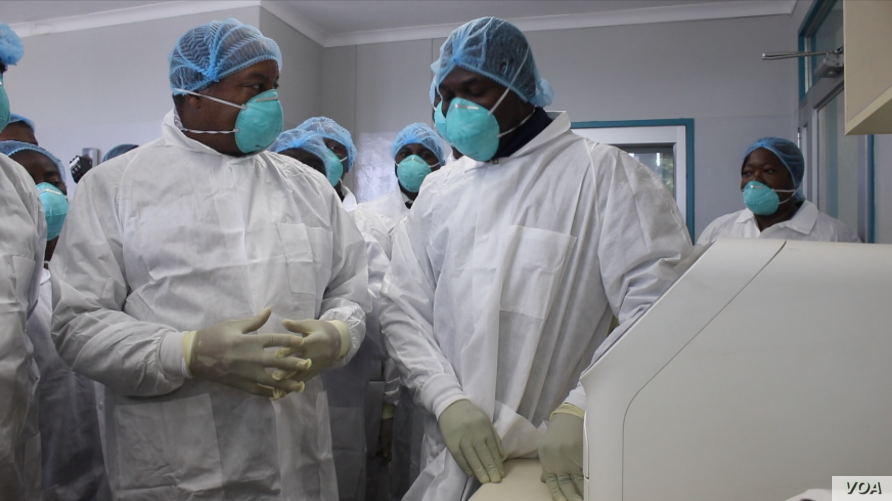A COVID-19 epidemiological model developed by London’s Imperial College makes grave predictions about the pandemic’s final death toll, not just for Zimbabwe, but for the whole world.
In the March 26 model’s worst case scenario for the world, in which no action is taken to counter the coronavirus, 40 million people die, out of 7 billion infections.
In Zimbabwe’s case, the model forecasts as many as 33,000 COVID-19 deaths, with 96% of the population being infected, if the country chose not to adopt any measures to stop the spread of the pandemic.
Mitigation would still see 14,943 deaths from 8.37 million cases.
As of April 16, Zimbabwe had 24 confirmed coronavirus infections and three deaths from 1,299 tests. The country went under a 21-day national lockdown on March 30.
Zimbabwe’s government has described the Imperial College models as misleading as it was based on the wrong assumptions and insufficient data.
“We are saying, let us do things the right way so that we get the right data,” Dr Agnes Mahomva, permanent secretary in the health ministry, told state media this week. “I must say that modelling is a bit misleading.”
Local extrapolations
An April 13 report by local civil society group, Platform for Concerned Citizens, uses the Imperial College model to build its own COVID-19 threat assessment for Zimbabwe.
Using the Imperial College model and citing “the collapsed health care system in Zimbabwe today”, the Platform for Concerned Citizens extrapolates that COVID-19 deaths in the country could be as high as 150,000.
“Assuming that, in the absence of hospital capacity, at least half of those requiring hospitalisation will die, the number of deaths in Zimbabwe would be between 75,000 and 150,000,” the Platform for Concerned Citizens says.
It is important to stress that this particular projection is not from the Imperial College model and uses a much higher fatality rate of about 60% among patients needing hospitalisation. The basis of this Platform for Concerned Citizens prediction is unclear.
A recent study reviewed by Lancet shows a fatality rate of 4.3% among COVID-19 patients requiring hospitalisation.
The Platform for Concerned Citizens report goes on to predict a mutiny by security personnel, public disorder and lawlessness as citizens protest against the government-imposed lockdown. None of this appears in the actual Imperial College report. Almost three weeks into the lockdown, none of this has come to pass.
What is epidemiological modelling?
The US Centres for Disease Control (CDC) defines epidemiology as the scientific, systematic and data-driven study of the distribution and determinants of health-related states and events, including but not limited to diseases, in specified populations. It is also the application of this study to the control of health problems.
Herbert W. Hethcote, a leading American mathematical epidemiologist, says an epidemiological model is a tool which uses a microscopic description (the role of an infectious individual) to predict the macroscopic behavior of disease spread through a population.
Since repeatable experiments and accurate data are usually not available in epidemiology, mathematical models and computer simulations can be used to perform needed theoretical experiments, Hethcote writes in “Three Basic Epidemiological Models” .
What does the Imperial College model predict?
The model has projections for 201 countries and territories, including Zimbabwe.
According to its worst case ‘unmitigated’ scenario, in which the world does nothing to stop the spread of the virus, the novel coronavirus would infect 7 billion people and cause some 40 million deaths this year.
The model predicts as many as 33,073 COVID-19 deaths in Zimbabwe, from 13.98 million infections, if the country chose not to adopt any measures to stop the spread of the coronavirus. Mitigation would still see 14,943 deaths from 8.37 million cases.
The model considers varying scenarios ranging from no mitigation, enhanced social distancing of the elderly to social distancing of the whole population.
Zambia and South Africa would, in their worst case scenarios, see up to 31,238 deaths (17 million infections) and 221,280 (from 54 million infections), respectively, according to the model.
Mozambique would have up to 64,725 deaths from 29 million infections, while Botswana would lose as much as 7,273 lives from 2.2 million cases.
The model predicts worst cases of 623,230 COVID-19 deaths in the UK, from 15.7 million infections, and 2.78 million fatalities in the USA, from 299 million cases.
However, the Imperial College researchers say their modelling showed that the early implementation of measures to stop the spread of the coronavirus, which most countries have done, had a dramatic impact. Global deaths would be down to between 1 million and 10 million under this scenario.
“If a suppression strategy is implemented early (at 0.2 deaths per 100,000 population per week) and sustained, then 38.7 million lives could be saved whilst if it is initiated when death numbers are higher (1.6 deaths per 100,000 population per week) then 30.7 million lives could be saved,” the researchers say in a report on their model.
“Delays In implementing strategies to suppress transmission will lead to worse outcomes and fewer lives saved.”
On March 25, lead Imperial College researcher Neil Ferguson told British lawmakers that UK deaths were now likely to be much lower than 20,000.
Credit and criticism
The Imperial College study has been credited with changing the UK government’s strategy and influencing modelling by US President Donald Trump’s COVID-19 taskforce.
The UK only belatedly followed other European countries in banning mass gatherings and closing schools, after initially championing a ‘herd immunity’ strategy that would allow 60% of the population to contract the coronavirus, getting mild sickness and building up immunity as a result.
“Communities will become immune to it and that’s going to be an important part of controlling this longer term. About 60 per cent is the sort of figure you need to get herd immunity,” said Patrick Vallance, the UK government’s chief scientific advisor.
“If you suppress something very, very hard, when you release those measures it bounces back and it bounces back at the wrong time.”
According to the BBC, the Imperial College model was decisive in changing the UK government’s approach to the pandemic.
Responding to critics of the Imperial College model who labelled it “apocalyptic” and “wild” on account of the wide gap between its predicted outcomes and patterns emerging in the UK, USA and elsewhere, Zeynep Tufekci, an associate professor at the University of North Carolina argued that epidemiological models are not necessarily to be right, but to trigger policy changes.
“These models are not snapshots of the future. They always describe a range of possibilities – and those possibilities are highly sensitive to our actions,” Tufekci wrote in The Atlantic.
“So, if epidemiological models don’t give us certainty – and asking them to do so would be a big mistake – what good are they? Epidemiology gives us something more important: agency to identify and calibrate our actions with the goal of shaping our future.”
The New England Complex Systems Institute (NECSI), an American research institute, is scathing in its criticism of the Imperial College researchers’ modelling.
“They make structural mistakes in analysing outbreak response. They ignore standard contact tracing allowing isolation of infected prior to symptoms. They also ignore door-to-door monitoring to identify cases with symptoms. Their conclusions that there will be resurgent outbreaks are wrong,” NECSI academics wrote.
“While the efforts to model social response are important, leaving out critical aspects of the response yields incorrect answers. Focusing on details but using incorrect assumptions makes for bad policy advice. Where lives are at stake, it is essential for science to adhere to higher standards.”
Conclusion:
Epidemiologists have, for years, used models to predict how infections progress through a specified population.
They also concede there are many problems with modelling a new virus such as the severe acute respiratory syndrome coronavirus 2 (SARS-CoV-2), which causes COVID-19, because it still has a lot of unknowns.
However, models are useful in guiding policy responses to infectious diseases. Champions of disease simulations believe models can fall victim to their own success – if a model inspires action, it necessarily ‘proves’ itself wrong.
The Imperial College COVID-19 model might have shocked some authorities into drastic action to stop the spread of the novel coronavirus, but its best-case prediction of up to 10 million global deaths, 14,000 of those in Zimbabwe alone, is looking increasingly counter-intuitive.
————————
Do you want to use our content? Click Here












